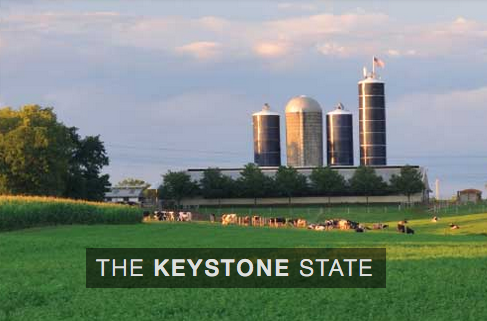Almost every four years Pennsylvania is treated as a swing state, but it has a persistent lean. It has been at least slightly more Democratic than the rest of America for more than 60 years, longer than Massachusetts or Minnesota or any other state. Since 1952, whenever the Democrats have lost Pennsylvania, they’ve lost the country by at least seven points.
(Un)Conventional Wisdom is presenting a history of each state’s role in modern presidential politics. Pennsylvania is the second in the series.
Working-class Catholic voters had a lot to do with Pennsylvania’s shift to the Democratic base after World War II—a couple of decades after it was one of only seven states willing to give Republican Herbert Hoover a second term. In 1960, John F. Kennedy did better than any Democrat had since before the Civil War in Lackawanna County (including Joe Biden’s birthplace of Scranton) and Luzerne County (Wilkes-Barre), both in the state’s northeastern coal-mining region. The two counties gave Kennedy more than half of his statewide victory margin and reinforced the idea that the Democrats couldn’t win Pennsylvania, and probably not the presidency, without a big labor-union vote.
Those days are gone. As Nate Cohn wrote in 2012, “over the last three decades, Pennsylvania’s flagging manufacturing industry was superseded by a diversifying post-industrial economy. Even Pittsburgh, the city with a football team called the ‘Steelers,’ is now dominated by burgeoning health care, education, finance, and high-tech sectors.”
That’s the big economic change. The big political change in Pennsylvania is that Democrats now rely on big margins in Philadelphia and its suburbs, rather than in places like Pittsburgh and Scranton. Three suburban counties (Bucks, Delaware, and Montgomery) are indicative of both state and national trends. They all voted Republican in every election from 1968 through 1988, then voted Democratic in every election from 1992 through 2012. In order to win the state, a GOP candidate will have to recapture part of George H.W. Bush’s popularity along the Main Line.
As southeastern Pennsylvania has become more Democratic in national elections, the western part of the state has moved in the opposite direction. The Pittsburgh area tops a crescent where Barack Obama did worse in 2008 than John Kerry did in 2004, a group of counties that follows the Appalachians to the south and then heads west to Arkansas and Oklahoma. That explains why Mitt Romney suddenly targeted the state in the last days of the 2012 campaign (hoping to benefit from anger over Obama’s “war on coal”). He was following in the footsteps of John McCain, who made a late push here in 2008—which prompted Bill and Hillary Clinton to come in and talk up Obama in what Time magazine’s Sean Scully described as “the western and central parts of the state, where a vast swath of rural areas and aging industrial towns have earned it the nickname Pennsyltucky.”

The problem for the Republicans is that western Pennsylvania is growing more slowly than the rest of the state. Take Westmoreland County, part of the Pittsburgh metro area. Kennedy won it with 55 percent in 1960, and Romney won it with 61 percent in 2012, a big turnaround for the Republican Party. But voter turnout barely budged over that half-century, rising from 155,000 to 170,000. In contrast, look at Montgomery County, which includes suburbs northwest of Philadelphia. It went from 61 percent for Richard Nixon in 1960 to 57 percent for Obama in 2012, and its turnout was up from 235,000 to 413,000. Clearly a better deal for the Democrats.
Then there is Philadelphia, which has become more valuable for the Democrats even as its population has declined. The record number of votes cast in Philadelphia was in 1952, when the electorate totaled 959,000. Democrat Adlai Stevenson won 58 percent of the vote and got a victory margin of 160,000 (but lost the state to Dwight Eisenhower). In 2012, the city’s vote total was down to 691,000, or more than a quarter off its height, but Obama’s victory margin was a record 492,000. (His statewide victory margin was 310,000.)
Obama got 85 percent of the vote in Philadelphia, another record. In 59 precincts, there were no recorded votes at all for Mitt Romney, which Fox News’s Sean Hannity protested was “mathematically impossible” but was part of a nationwide pattern of a steady decline in support for the GOP in nearly all-black neighborhoods.
To win the state in 2016, the Republican nominee almost certainly needs to improve on Romney’s 14 percent in Philadelphia. (Republican Arlen Specter got 28 percent there in 2004, when he won re-election as U.S. senator.) More importantly, the GOP needs to begin reversing the Democratic trend in the Philly suburbs—if not by moving to the center on cultural issues like gay marriage and climate change, then by reviving fears of the Democrats as the party of high taxes and weak national defense.
Because it’s so late in the season, Pennsylvania’s Republican presidential primary hasn’t been seriously contested since 1980, when George H.W. Bush beat Ronald Reagan by seven points, carrying the big suburban counties outside Philadelphia (but losing the city itself). If there’s still a race when Pennsylvania votes late next April, another Bush could be counting on those suburbs to outweigh the more conservative areas of the state.
Pennsylvania demographics (Census Bureau)
Where Pennsylvania residents come from (New York Times)
Religious composition of Pennsylvania (Pew Research Center)
Pennsylvania Department of State (Voting and Elections)
Note: The best source for state- and county-level presidential election results is Dave Leip’s Atlas of Presidential Elections.

Pennsylvania has been more Democratic than the U.S. as a whole since 1952 (when Republican Dwight Eisenhower won the state by six points, versus 11 points nationwide).
More: Delaware, New Jersey, Georgia, Connecticut








